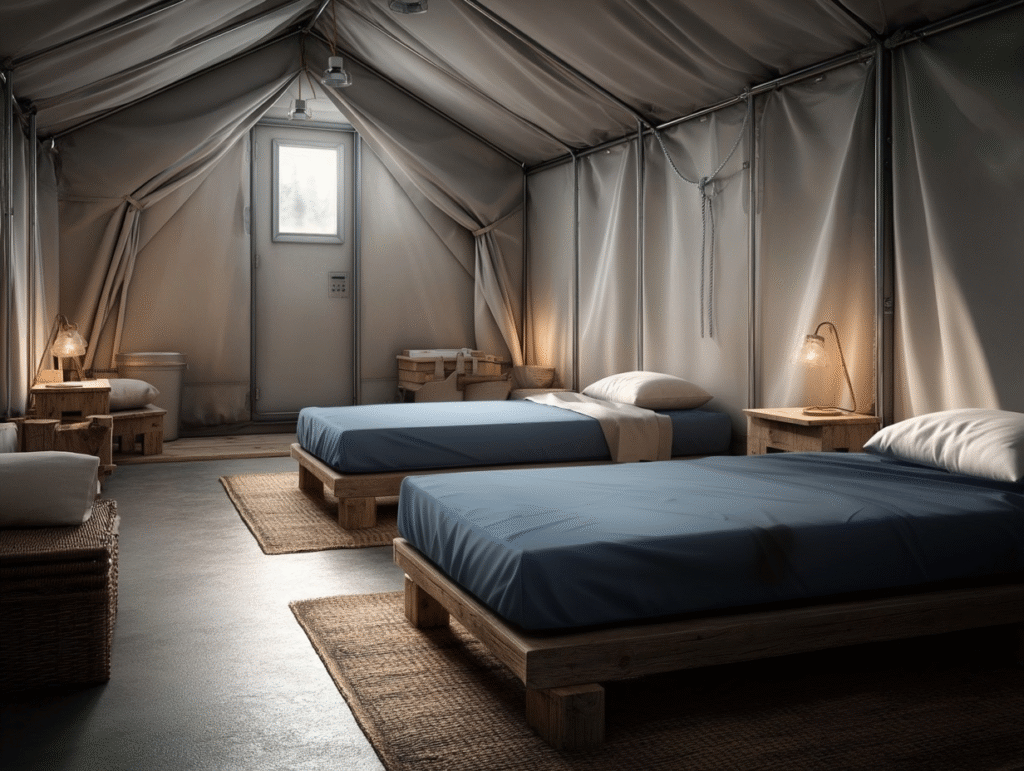When it comes to providing emergency housing and shelter services, every detail matters in preserving human dignity and promoting health. Among the most critical yet often overlooked elements is the humble mattress.
The right shelter mattress can mean the difference between a restorative night’s sleep and a sleepless night of discomfort, between maintaining health and facing hygiene-related illnesses.
This comprehensive guide explores everything shelter operators, humanitarian organizations, and facility managers need to know about selecting, maintaining, and maximizing the impact of shelter mattresses.
Why Shelter Mattresses Matter More Than You Think? A Deeper Dive
The Human Element
Sleep is a fundamental human need, not a luxury.
For individuals experiencing homelessness, displacement, or crises, a clean, comfortable mattress represents more than just a place to rest—it’s a symbol of dignity, care, and hope.
Quality sleep directly impacts physical health, mental well-being, and the ability to rebuild one’s life.
The Public Health Imperative
Poor-quality or unsanitary sleeping surfaces in shelters can become breeding grounds for bacteria, bed bugs, and other pests.
This creates health risks not just for current residents, but for the broader community. Investment in proper mattresses is an investment in public health.
Economic Considerations
While quality shelter mattresses require upfront investment, they prove cost-effective over time through:
- Reduced replacement frequency
- Lower maintenance costs
- Decreased health-related incidents
- Improved shelter reputation and funding opportunities
Why the Right Mattresses Matter for Shelters and Rescue Missions?
Picture this: a shelter director walks through a dormitory after a long night. The mattresses are worn thin, the vinyl is cracked, and the staff spent hours scrubbing instead of focusing on residents.
The problem isn’t just furniture—it’s dignity, hygiene, and safety on the line.
This is where shelter mattresses step in. Unlike consumer-grade bedding, these mattresses are built for heavy use, easy sanitation, and the comfort people need during vulnerable moments.
We’ll explore further what makes a shelter mattress different, why it matters, and how to choose the best option for your facility.
What Makes a Shelter Mattress Different?
A shelter mattress isn’t just a bed—it’s a frontline defense against wear, infection, and costly replacements. Here’s what separates it from standard mattresses:
- Durability: High-density CertiPUR-US® foam or coil systems that resist sagging, even under 24/7 use.
- Sanitation: Waterproof, antimicrobial vinyl or nylon covers that wipe clean in minutes.
- Safety Compliance: Flame-retardant materials meeting federal CFR 16 Part 1633 standards.
- Bed Bug Resistance: Seam construction is designed to eliminate hiding spots.
In group-living environments where turnover is high, these features aren’t luxuries—they’re survival essentials.
The Benefits of Choosing the Right Shelter Mattress
There are several benefits of choosing the right kind of mattresses suitable for shelter and rescue missions. And the benefits can be manifold, so are the benefactors.
-
For Shelter Providers
Running a shelter or mission means balancing limited budgets with high demands. Here, shelter mattresses help save costs in the long run.
Here’s how:
- Fewer replacements: Tough construction means they last for years.
- Faster cleaning: Staff can wipe down surfaces instead of replacing stained bedding.
- Regulatory peace of mind: Fire safety and hygiene compliance are already built in.
-
For Residents
Residents in a shelter deserve more than just “a place to sleep.” It’s basic and dignified.
Thus, a quality shelter mattress:
- Supports healthy posture and reduces stress.
- Creates a dignified environment that communicates care.
- Lowers risks of skin irritation or infection from unhygienic surfaces.
-
For Operations
Efficiency matters. With quick sanitization, staff can prepare rooms faster, improve turnover, and keep focus on people—not worn-out equipment.
Key Features to Look For in a Shelter Mattress
When evaluating mattresses for shelters and missions, focus on these must-have features:
- High-Density Foam Core: Supports long-term use without sagging.
- Waterproof Covers: Essential for hygiene—vinyl or nylon options available.
- Antimicrobial Protection: Prevents the growth of bacteria, mold, and odors.
- Tear Resistance: Withstands constant turnover and rough use.
- Fire Safety Compliance: Meets 16 CFR 1633 fire-retardant regulations.
- Bed Bug Resistant Seams: Keeps mattresses protected in high-turnover environments.
Types of Shelter Mattresses Available
At Camp Mattresses To Go, the DuraRest line is specifically engineered for shelters and missions. Here are your main options:
- DuraRest Nylon Foam – Softer feel, cooler surface, made with 1.8-density foam, backed by an 8-year warranty.
- DuraRest Vinyl Foam – Firmer, warmer surface, 1.5-density foam, with a 5-year warranty.
- DuraRest Nylon Innerspring – Pocketed coil support with a softer feel, offering a 10-year warranty.
- DuraRest Vinyl Innerspring – Firmer innerspring support, easier to sanitize, backed by an 8-year warranty.
Pro tip: Nylon covers are slightly more breathable and softer, while vinyl covers are ultra-durable and wipe clean instantly.
How to Choose the Right Shelter Mattress?
Not every facility has the same needs. Here are the decision factors to weigh before buying:
-
Resident Demographics:
- Adults vs. children? Elderly or mobility-challenged individuals?
- Foam mattresses are excellent for general comfort, while innerspring mattresses may suit longer stays.
-
Stay Duration:
- Short-term shelters may prioritize quick sanitation.
- Long-term housing may need more comfort and pressure relief.
-
Budget vs. Longevity:
- A lower upfront cost may mean frequent replacements.
- Higher-density foam and longer warranties save more over time.
-
Operational Needs:
- If turnover is high, vinyl covers may be ideal for instant cleaning.
- For facilities prioritizing comfort, nylon may strike the better balance.
Real-World Insights from Shelter Operators
Shelter administrators consistently highlight three pain points:
- Mattresses that wear out too fast.
- Beds that take too long to clean.
- Products that aren’t built for safety or sanitation.
The right shelter mattress solves all three.
As one facilities manager once put it:
“When mattresses hold up night after night, we can focus less on replacements and more on serving people.”
Frequently Asked Questions (FAQs)
-
What is a shelter mattress?
A mattress built specifically for shelters, missions, and group-living facilities. Designed for durability, sanitation, and compliance.
-
How long does a shelter mattress last?
With warranties of 5–10 years, high-quality shelter mattresses are engineered for years of heavy use.
-
Are they waterproof?
Yes—vinyl and nylon covers are waterproof and wipe-clean.
-
Do they meet fire safety standards?
All DuraRest shelter mattresses comply with federal CFR 16 Part 1633 regulations.
Conclusion: Built to Last, Built for Care
At the heart of every shelter is the mission to provide dignity and safety. A shelter mattress isn’t just equipment—it’s a tool for healing, rest, and operational efficiency. Resilience has to be its core value.
If you’re ready to reduce costs, simplify cleaning, and improve resident care, now is the time to upgrade.
Explore our Shelter & Mission Mattresses today and request a quote or sample. Durable. Hygienic. Made in the USA.

